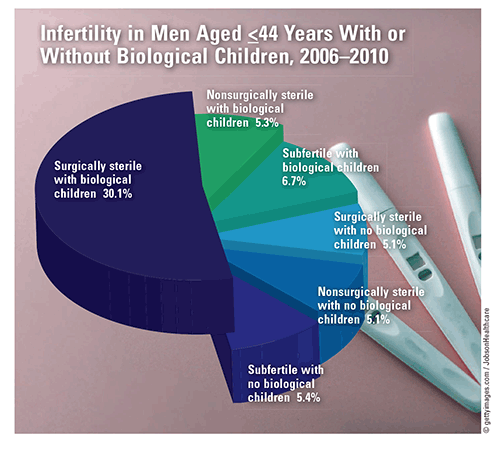US Pharm. 2019;44(8):12.
According to data from the CDC, from 2006 to 2010, 10% to 15% of the sexually active population experienced infertility, with men accounting for about one-half of persons affected. After age 29 years in men, birth rates were found to decline.

Sterility: Surgical sterility was the major contributor to male infertility; its prevalence increased from 3.4% in men aged 25 to 29 years to 39.7% in those aged 40 to 44 years. The prevalence of nonsurgical sterility in men aged 25 to 29 years was 4.4%, increased to 5% in those aged 30 to 34 years, and peaked at 6.1% in those aged 40 to 44 years. The prevalence of male subfertility increased from 4.4% in those aged 25 to 29 years to 6.8% in those aged 30 to 34 years and peaked at 7.7% in those aged 35 to 39 years. There was a 21% drop in subfertility between ages 35 to 39 years and 40 to 44 years.
Biological Children: In men without biological children, the rate of surgical sterilization was 5% in those aged 30 to 34 years, 7.8% for ages 35 to 39 years, and 11.2% for ages 40 to 44 years. In men without biological children, nonsurgical sterility was 7.2% in those aged 40 to 44 years, 4.6% for ages 35 to 39 years, and 5.8% for ages 30 to 34 years. The rate of subfertility in men without biological children was 7.2% in those aged 30 to 34 years, 7.1% for ages 35 to 39 years, and 6.7% for ages 40 to 44 years. In men with one or more biological children, the prevalence of surgical sterility was 6% in those aged 25 to 29 years, 20.1% for ages 30 to 34 years, 32.4% for ages 35 to 39 years, and 48.4% for ages 40 to 44 years. In men who had one or more biological children, nonsurgical sterility was lowest (4.5%) in those aged 30 to 34 years and 5.8% in those older than 35 years. In men with one or more children, subfertility was higher in those aged 35 to 39 years (7.9% vs. 6% for other ages).
Ethnicity: Of all infertile men, non-Hispanic white men had the highest rate of surgical sterilization (23.1%), followed by Hispanic (16.7%), non-Hispanic African American (16.6%), and Asian men (3.5%). Prevalence was reversed for nonsurgical sterility: Asian men had the highest rate (8.4%), followed by Hispanic (7.6%), non-Hispanic African American (6.4%), and non-Hispanic white men (4.2%). Subfertility rates were higher in non-Hispanic white and non-Hispanic African American men (6.9% and 6.8%, respectively) than in men who were Hispanic (5.2%) or Asian (4.3%).
To comment on this article, contact rdavidson@uspharmacist.com.






